Potential of an Area in Terms of Pro-Climate Solutions in a Land Consolidation Project
Abstract
1. Introduction
2. Literature Review
2.1. Renaturalisation of Watercourses
2.2. Shelter Belts, Woodlots, Afforestation, Roadside Tree Clumps, Buffer Vegetation Strips between a River and a Field under Cultivation
2.3. Field–Forest Boundary, Field Margin
2.4. Ecological Corridors, Afforestation, and Land Reclamation
2.5. Anti-Erosion Turfing
2.6. Drainage Ditches, Storage Reservoirs
2.7. Agricultural Transport Roads
2.8. Land Consolidation in Poland
3. Materials and Methods
3.1. Study Area
3.2. Methodology
3.2.1. Construction of Pro-climatic Index
3.2.2. Data
3.2.3. Spatial Analysis
4. Results
4.1. Variability of the Studied Attributes Affecting the Index of the Potential for Pro-Climate Solutions
4.2. Standardisation of Indicators
4.3. The Hierarchy of Objects in Terms of the Potential for Pro-climate Solutions
4.4. Spatial Analysis
5. Discussion
5.1. Pro-Climatic Solution
5.2. Limitations of the Research
6. Conclusions and Implications for Land Policy
Author Contributions
Funding
Institutional Review Board Statement
Informed Consent Statement
Data Availability Statement
Conflicts of Interest
Nomenclature
| Symbol | Feature |
| value of weight of jth variable | |
| value of the jth variable for ith spatial unit | |
| the maximum value of the jth variable for ith spatial unit | |
| the minimum value of the jth variable for ith spatial unit | |
| Ik | the global Moran’s index for the kth index |
| n | the total number of spatial units |
| the values of jth variable for ith and i’th compared spatial units | |
| the mean value of the variable for all jth spatial units | |
| elements of the spatial matrix of weights for ith and i’th spatial units | |
| the value of aggregate weights in k index | |
| Z(I)k | the number of standard deviations of Moran’s I about the mean in the kth index |
| E(I)k | the expected value of Moran’s I in the kth index |
| Var(I)k | the variance value of Moran’s I in the kth index |
| elements of the spatial matrix of weights for i’th and ith spatial units | |
| quantity of sum of weights in the column of jth variable | |
| quantity of sum of the weights in the row of jth variable |
References
- O’Neill, B.C.; Oppenheimer, M.; Warren, R.; Hallegatte, S.; Kopp, R.E.; Pörtner, H.O.; Scholes, R.; Birkmann, J.; Foden, W.; Licker, R.; et al. IPCC reasons for concern regarding climate change risks. Nat. Clim. Chang. 2017, 7, 28–37. [Google Scholar] [CrossRef]
- Ružbarský, J. Soil carbon stocks and land use change: A meta-analysis. Glob. Change Biol. 2002, 8, 345–360. [Google Scholar] [CrossRef]
- Li, X.; Hui, N.; Yang, Y.; Ma, J.; Luo, Z.; Chen, F. Short-term effects of land consolidation of dryland-to-paddy conversion on soil CO2 flux. J. Environ. Manag. 2021, 292, 112691. [Google Scholar] [CrossRef] [PubMed]
- Guo, B.; Fang, Y.; Jin, X.; Zhou, Y. Monitoring the effects of land consolidation on the ecological environmental quality based on remote sensing: A case study of Chaohu Lake Basin, China. Land Use Policy 2020, 95, 104569. [Google Scholar] [CrossRef]
- Boateng, I.; Dalyot, S.; Enemark, S.; Friesecke, F.; Mitchell, D.; van der Molen, P.; Pearse, M.; Sutherland, M.; Vranken, M. The Surveyors’ Role in Monitoring, Mitigating, and Adapting to Climate Change; International Federation of Surveyors: Copenhagen, Denmark, 2014. [Google Scholar]
- Budziszewska, M.; Kardaś, A.; Bohdanowicz, Z.; Klimatyczne, A.B.C. Interdyscyplinarne Podstawy Współczesnej Wiedzy o Zmianie Klimatu; Wydawnictwa Uniwersytetu: Warszawskiego, Poland, 2021. [Google Scholar]
- Wilson, E.O. Half-Earth: Our Planet’s Fight for Life; WW Norton & Company: New York, NY, USA, 2016. [Google Scholar]
- Ritchie, H.; Roser, M. Land Use. 2013. Available online: https://ourworldindata.org/land-use (accessed on 26 October 2022).
- Vitikainen, A. An Overview of Land Consolidation in Europe. Nord. J. Surv. Real Estate Res. 2004, 1, 25–43. [Google Scholar]
- Pašakarnis, G.; Maliene, V. Towards sustainable rural development in Central and Eastern Europe: Applying land consolida-tion. Land Use Policy 2010, 27, 545–549. [Google Scholar] [CrossRef]
- Demetriou, D.; Stillwell, J.; See, L. Land consolidation in Cyprus: Why is an integrated planning and decision support system required? Land Use Policy 2012, 29, 131–142. [Google Scholar] [CrossRef]
- Zhou, Y.; Li, Y.; Xu, C. Land consolidation and rural revitalization in China: Mechanisms and paths. Land Use Policy 2020, 91, 104379. [Google Scholar] [CrossRef]
- Wei, X.; Liu, Y.; Wang, N. Spatial disparity pattern of land consolidation projects in Hubei province. Trans. Chin. Soc. Agric. Eng. 2014, 30, 195–203. [Google Scholar]
- Uyan, M.; Cay, T.; Inceyol, Y.; Hakli, H. Comparison of designed different land reallocation models in land consolidation: A case study in Konya/Turkey. Comput. Electron. Agric. 2015, 110, 249–258. [Google Scholar] [CrossRef]
- Shi, Y.; Cao, X.; Fu, D.; Wang, Y. Comprehensive Value Discovery of Land Consolidation Projects: An Empirical Analysis of Shanghai, China. Sustainability 2018, 10, 2039. [Google Scholar] [CrossRef]
- Du, H. Application of vetiver grass in slope retaining and consolidation project in suide test area. J. Discret. Math. Sci. Cryptogr. 2017, 20, 1321–1326. [Google Scholar] [CrossRef]
- Van Dijk, T. Dealing with Land Fragmentation in Central Europe: A Critical Assessment on the Use of Western Instruments; Eburon: Delft, The Netherlands, 2003; p. 228. [Google Scholar]
- Van Dijk, T. Complications for traditional land consolidation in Central Europe. Geoforum 2007, 38, 505–511. [Google Scholar] [CrossRef]
- Hartvigsen, M. Land Consolidation in Central and Eastern European Countries. In Proceedings of the Shaping the Change, XXIII FIG Congress, Munich, Germany, 8–13 October 2006. [Google Scholar]
- Bonadonna, A.; Rostagno, A.; Beltramo, R. Improving the Landscape and Tourism in Marginal Areas: The Case of Land Consolidation Associations in the North-West of Italy. Land 2020, 9, 175. [Google Scholar] [CrossRef]
- Jin, X.; Zhang, Z.; Wu, X.; Xiang, X.; Sun, W.; Bai, Q.; Zhou, Y. Co-ordination of land exploitation, exploitable farmland reserves and national planning in China. Land Use Policy 2016, 57, 682–693. [Google Scholar] [CrossRef]
- Ntihinyurwa, P.D.; de Vries, W.T.; Chigbu, U.E.; Dukwiyimpuhwe, P.A. The positive impacts of farm land fragmentation in Rwanda. Land Use Policy 2018, 81, 565–581. [Google Scholar] [CrossRef]
- Tang, X.; Pan, Y.; Liu, Y. Analysis and demonstration of investment implementation model and paths for China’s cultivated land consolidation. Appl. Geogr. 2017, 82, 24–34. [Google Scholar] [CrossRef]
- Wójcik-Leń, J.; Sobolewska-Mikulska, K.; Sajnóg, N.; Leń, P. The idea of rational management of problematic agricultural areas in the course of land consolidation. Land Use Policy 2018, 78, 36–45. [Google Scholar] [CrossRef]
- Qu, Y.; Jiang, G.-h.; Li, Z.; Tian, Y.; Wei, S. Understanding rural land use transition and regional consolidation implications in China. Land Use Policy 2019, 82, 742–753. [Google Scholar] [CrossRef]
- Li, Y.; Liu, Y.; Long, H.; Cui, W. Community-based rural residential land consolidation and allocation can help to revitalize hollowed villages in traditional agricultural areas of China: Evidence from Dancheng County, Henan Province. Land Use Policy 2014, 39, 188–198. [Google Scholar] [CrossRef]
- Jabłońska, E.; Wiśniewska, M.; Marcinkowski, P.; Grygoruk, M.; Walton, C.R.; Zak, D.; Hoffmann, C.C.; Larsen, S.E.; Trepel, M.; Kotowski, W. Catchment-Scale Analysis Reveals High Cost-Effectiveness of Wetland Buffer Zones as a Remedy to Non-Point Nutrient Pollution in North-Eastern Poland. Water 2020, 12, 629. [Google Scholar] [CrossRef]
- Lovell, S.T.; Sullivan, W.C. Environmental benefits of conservation buffers in the United States: Evidence, promise, and open questions. Agric. Ecosyst. Environ. 2006, 112, 249–260. [Google Scholar] [CrossRef]
- Pijanowski, J.M.; Bogdał, A.; Książek, L.; Wojewodzic, T.; Kowalik, T.; Wałęga, A.; Zarzycki, J.; Zadrożny, P.; Nicia, P.; Strużyński, A.; et al. Środowiskowe i Społeczne Efekty Scaleń Gruntów; Wydawnictwo Uniwersytetu Rolniczego w Krakowie: Wydawnictwo, Poland, 2021. [Google Scholar]
- Kundzewicz, Z.; Banasik, K.; Błażejewski, R.; Januchta-Szostak, A.; Jokiel, P.; Kochanek, K.; Kutek, K.; Konieczny, R.; Majewski, W.; Nachlik, E.; et al. Alert wodny 2. Konieczna Jest Redukcja Ryzyka Powodzi i Suszy; Open Eyes Economy: Kraków, Poland, 2020. [Google Scholar]
- Alfieri, L.; Feyen, L.; Di Baldassarre, G. Increasing flood risk under climate change: A pan-European assessment of the benefits of four adaptation strategies. Clim. Chang. 2016, 136, 507–521. [Google Scholar] [CrossRef]
- Duan, H.; Lu, X.; Talamini, G. The Impacts of Environmentally Mitigated River Channelization on Agriculture in Hong Kong. Urbannie Urbanus J. 2022, 7, 145–156. [Google Scholar]
- Verbrugge, L.; Born, R.V.D. The role of place attachment in public perceptions of a re-landscaping intervention in the river Waal (The Netherlands). Landsc. Urban Plan. 2018, 177, 241–250. [Google Scholar] [CrossRef]
- Juan, A.; Gori, A.; Sebastian, A. Comparing flood plain evolution in channelized and unchannelized urban watersheds in Houston, Texas. J. Flood Risk Manag. 2020, 13, e12604. [Google Scholar] [CrossRef]
- Duh, J.-D.; Shandas, V.; Chang, H.; George, L.A. Rates of urbanisation and the resiliency of air and water quality. Sci. Total Environ. 2008, 400, 238–256. [Google Scholar] [CrossRef]
- Palmer, M.A.; Bernhardt, E.S.; Allan, J.D.; Lake, P.S.; Alexander, G.; Brooks, S.; Carr, J.; Clayton, S.; Dahm, C.N.; Follstad Shah, J.; et al. Standards for ecologically successful river restoration. J. Appl. Ecol. 2005, 42, 208–217. [Google Scholar] [CrossRef]
- Talamini, G.; Zhang, Q.; Viganò, P. The condition of urban agriculture in a Chinese global city: Evidence from the field. Environ. Urban. 2022, 34, 99–121. [Google Scholar] [CrossRef]
- Jacobs, M.H.; Buijs, A.E.; 2011. Understanding stakeholders’ attitudes toward water management interventions: Role of place meanings. Water Resour. Res. 2011, 47, 1–11. [Google Scholar] [CrossRef]
- Dixon, A.B.; Hailu, A.; Wood, A.P. The role and importance of wetlands in Ethiopia. In Proceedings of the Wetland Awareness Creation and Activity Identification Workshop in Amhara National Regional State, Bahar Dar, Ethiopia, 23 January 2001; pp. 8–13. [Google Scholar]
- Mioduszewski, W.; Okruszko, H.; Łoś, M. Rola Melioracji W Środowisku Przyrodniczym; Wydawnictwo Komitetu Melioracji i Inżynierii Środowiska Rolniczego PAN: Warszawa, Poland, 1990. [Google Scholar]
- Józefaciuk, A.; Józefaciuk, C. Ochrona Gruntów Przed Erozją; Wydawnictwo IUNG: Puławy, Poland, 1999. [Google Scholar]
- Strazzera, E.; Atzori, R.; Meleddu, D.; Statzu, V. Assessment of renaturation measures for improvements in ecosystem services and flood risk mitigation. J. Environ. Manag. 2021, 292, 112743. [Google Scholar] [CrossRef] [PubMed]
- Odjugo, P.A.-A.O. Quantifying the Cost of Climate Change Impact in Nigeria: Emphasis on Wind and Rainstorms. J. Hum. Ecol. 2009, 28, 93–101. [Google Scholar] [CrossRef]
- Zajączkowski, J. Zadrzewienia—Narzędzie kształtowania środowiska na terenach rolniczych. In Proceedings of the XIX Konferencja Naukowa Nowe Tendencje W Teorii I Praktyce Urządzania Obszarów Wiejskich, Szczytno, Poland, 4–5 September 2014. [Google Scholar]
- Thaler, S.; Eitzinger, J.; Trnka, M.; Dubrovsky, M. Impacts of climate change and alternative adaptation options on winter wheat yield and water productivity in a dry climate in Central Europe. J. Agric. Sci. 2012, 150, 537–555. [Google Scholar] [CrossRef]
- Review on Windbreaks Agroforestry as a Climate Smart Agriculture Practices. Am. J. Agric. For. 2021, 9, 342. [CrossRef]
- Doelman, J.C.; Stehfest, E.; van Vuuren, D.P.; Tabeau, A.; Hof, A.F.; Braakhekke, M.C.; Gernaat, D.E.H.J.; Berg, M.v.D.; van Zeist, W.; Daioglou, V.; et al. Afforestation for climate change mitigation: Potentials, risks and trade-offs. Glob. Chang. Biol. 2019, 26, 1576–1591. [Google Scholar] [CrossRef] [PubMed]
- Liu, H.; Xu, C.; Allen, C.D.; Hartmann, H.; Wei, X.; Yakir, D.; Wu, X.; Yu, P. Nature-based framework for sustainable afforestation in global drylands under changing climate. Glob. Chang. Biol. 2022, 28, 2202–2220. [Google Scholar] [CrossRef]
- Forster, E.J.; Healey, J.R.; Dymond, C.; Styles, D. Commercial afforestation can deliver effective climate change mitigation under multiple decarbonisation pathways. Nat. Commun. 2021, 12, 3831. [Google Scholar] [CrossRef]
- Strandberg, G.; Kjellström, E. Climate Impacts from Afforestation and Deforestation in Europe. Earth Interact. 2019, 23, 1–27. [Google Scholar] [CrossRef]
- Chen, Z.; Yu, G.; Wang, Q. Effects of climate and forest age on the ecosystem carbon exchange of afforestation. J. For. Res. 2020, 31, 365–374. [Google Scholar] [CrossRef]
- Tamang, B.; Pala, N.A.; Shukla, G.; Rashid, M.; Rather, M.M.; Bhat, J.A.; Masoodi, T.; Chakravarty, S. Trees outside forest (TOFs) aids in mitigating global climatic change through carbon sequestration: Example from academic institutional landscapes. Acta Ecol. Sin. 2021, 41, 351–357. [Google Scholar] [CrossRef]
- Zaki, S.A.; Toh, H.J.; Yakub, F.; Saudi, A.S.M.; Ardila-Rey, J.A.; Muhammad-Sukki, F. Effects of Roadside Trees and Road Orientation on Thermal Environment in a Tropical City. Sustainability 2020, 12, 1053. [Google Scholar] [CrossRef]
- Brandle, J.R.; Hodges, L.; Zhou, X.H. Windbreaks in North American Agricultural Systems. Agronomy and Horticulture. Fac. Publ. 2004, 389, 65–78. Available online: https://digitalcommons.unl.edu/agronomyfacpub/389 (accessed on 20 February 2023).
- Mcnaughton, K. Effects of Windbreaks on Turbulent Transport and Microclimate. Agric. Ecosyst. Environ. 1988, 22, 17–39. [Google Scholar] [CrossRef]
- Cleugh, H.A. Field measurements of windbreak effects on airflow, turbulent exchanges and microclimates. Aust. J. Exp. Agric. 2002, 42, 665–677. [Google Scholar] [CrossRef]
- Cleugh, H.A.; Hughes, D.E. Impact of shelter on crop microclimates: A synthesis of results from wind tunnel and field experiments. Aust. J. Exp. Agric. 2002, 42, 679–701. [Google Scholar] [CrossRef]
- Chendev, Y.G.; Sauer, T.J.; Ramirez, G.H.; Burras, C.L. History of East European Chernozem Soil Degradation; Protection and Restoration by Tree Windbreaks in the Russian Steppe. Sustainability 2015, 7, 705–724. [Google Scholar] [CrossRef]
- Mander, Ü.; Tournebize, J.; Tonderski, K.; Verhoeven, J.T.; Mitsch, W.J. Planning and establishment principles for constructed wetlands and riparian buffer zones in agricultural catchments. Ecol. Eng. 2017, 103, 296–300. [Google Scholar] [CrossRef]
- Mander, Ü.; Tournebize, J.; Sauvage, S.; Sánchez-Perez, J.M. Wetlands and buffer zones in watershed management. Ecol. Eng. 2017, 103, 289–295. [Google Scholar] [CrossRef]
- Chabrerie, O.; Jamoneau, A.; Gallet-Moron, E.; Decocq, G. Maturation of forest edges are constrained by neighbouring agricultural land management. J. Veg. Sci. 2013, 24, 58–69. [Google Scholar] [CrossRef]
- Moreno, G.; Gonzalez-Bornay, G.; Pulido, F.; Lopez-Diaz, M.L.; Bertomeu, M.; Juarez, E.; Diaz, M. Exploring the causes of high biodiversity of Iberian dehesas: The importance of wood pastures and marginal habitats. Agrofor. Syst. 2016, 90, 87–105. [Google Scholar] [CrossRef]
- Paul, C.; Weber, M.; Knoke, T. Agroforestry versus farm mosaic systems—Comparing land-use efficiency, economic returns and risks under climate change effects. Sci. Total. Environ. 2017, 587–588, 22–35. [Google Scholar] [CrossRef] [PubMed]
- Fried, G.; Villers, A.; Porcher, E. Assessing non-intended effects of farming practices on field margin vegetation with a functional approach. Agric. Ecosyst. Environ. 2018, 261, 33–44. [Google Scholar] [CrossRef]
- Stein-Bachinger, K.; Gottwald, F.; Haub, A.; Schmidt, E. To what extent does organic farming promote species richness and abundance in temperate climates? A review. Org. Agric. 2020, 11, 1–12. [Google Scholar] [CrossRef]
- Visscher, A.M.; Vanek, S.; Meza, K.; de Goede, R.G.; Valverde, A.A.; Ccanto, R.; Olivera, E.; Scurrah, M.; Fonte, S.J. Eucalyptus and alder field margins differ in their impact on ecosystem services and biodiversity within cropping fields of the Peruvian Andes. Agric. Ecosyst. Environ. 2020, 303, 107107. [Google Scholar] [CrossRef]
- Wiström, B.; Nielsen, A.B. Decisive environmental characteristics for woody regrowth in forest edges—Patterns along complex environmental gradients in Southern Sweden. For. Ecol. Manag. 2016, 363, 47–62. [Google Scholar] [CrossRef]
- Sabatini, F.M.; Burrascano, S.; Tuomisto, H.; Blasi, C. Ground layer plant species turnover and beta diversity in Southern-European old-growth forests. PLoS ONE 2014, 9, e95244. [Google Scholar] [CrossRef]
- Beier, P. Conceptualizing and Designing Corridors for Climate Chang. Ecol. Restor. 2012, 4, 30. Available online: https://www.jstor.org/stable/43441504 (accessed on 20 October 2022).
- Błońska, E.; Lasota, J.; Vasconcelos da Silva, G.R.; Vanguelova, E.; Ashwood, F.; Tibbett, M.; Watts, K.; Lukac, M. Soil organic matter stabilization and carbon-cycling enzyme activity are affected by land management. Ann. For. Res. 2020, 63, 71–86. [Google Scholar] [CrossRef]
- Lindgren, J.; Kimberley, A.; Cousins, S.A.O. The complexity of forest borders determines the understorey vegetation. Appl. Veg. Sci. 2018, 21, 85–93. [Google Scholar] [CrossRef]
- Woch, F.; Borek, R. The Role Of Management Of The Field-Forest Boundary In Poland’s Process Of Agricultural Restructuring. Pap. Glob. Chang. IGBP 2015, 22, 83–100. [Google Scholar] [CrossRef]
- Beita, C.M.; Murillo, L.F.S.; Alvarado, L.D.A. Ecological corridors in Costa Rica: An evaluation applying landscape structure, fragmentation-connectivity process, and climate adaptation. Conserv. Sci. Pract. 2021, 3, e475. [Google Scholar] [CrossRef]
- Heller, N.E.; Zavaleta, E.S. Biodiversity management in the face of climate change: A review of 22 years of recommendations. Biol. Conserv. 2009, 142, 14–32. [Google Scholar] [CrossRef]
- Krosby, M.; Tewksbury, J.; Haddad, N.M.; Hoekstra, J. Ecological Connectivity for a Changing Climate. Conserv. Biol. 2010, 24, 1686–1689. [Google Scholar] [CrossRef] [PubMed]
- Watson, R.T.; Noble, I.R.; Bolin, B.; Ravindranath, N.H.; Verardo, D.J.; Dokken, D.J. (Eds.) Land Use, Land-Use Change, and Forestry; Cambridge University Press: Cambridge, UK, 2000. [Google Scholar]
- Munasinghe, M.; Swart, R. Primer on Climate Change and Sustainable Development; Cambridge University Press: Cambridge, UK, 2005. [Google Scholar]
- Harris, J.A.; Hobbs, R.J.; Higgs, E.; Aronson, J. Ecological Restoration and Global Climate Change. Restor. Ecol. 2006, 14, 170–176. [Google Scholar] [CrossRef]
- Jończyk, K. Ochrona Gruntów Przed Erozją; Ministerstwo Rolnictwa i Rozwoju Wsi: Warszawa, Poland, 2003. [Google Scholar]
- Reubens, B.; Poesen, J.; Danjon, F.; Geudens, G.; Muys, B. The role of fine and coarse roots in shallow slope stability and soil erosion control with a focus on root system architecture: A review. Trees 2007, 21, 385–402. [Google Scholar] [CrossRef]
- Gyssels, G.; Poesen, J.; Bochet, E.; Li, Y. Impact of plant roots on the resistance of soils to erosion by water: A review. Prog. Phys. Geogr. 2005, 29, 189–217. [Google Scholar] [CrossRef]
- Smith, S.; De Smet, I. Root system architecture: Insights from Arabidopsis and cereal crops. Philos. Trans. R. Soc. B Biol. Sci. 2012, 367, 1441–1452. [Google Scholar] [CrossRef]
- Skuodienė, R.; Kinderienė, I.; Tomchuk, D.; Šlepetys, J.; Karčauskienė, D. Root development of temporary and permanent grasslands and their anti-erosion significance on a hilly terrain. Zemdirb. Agric. 2020, 107, 209–216. [Google Scholar] [CrossRef]
- Wang, J.; Wang, K.; Zhang, M.; Zhang, C. Impacts of climate change and human activities on vegetation cover in hilly southern China. Ecol. Eng. 2015, 81, 451–461. [Google Scholar] [CrossRef]
- Xu, Y.; Yan, R.; Linqiang, T.; Kang, C.; Li, L. Experimental Study of Erosion on Expansive Soil Slope Strengthened by HPTRM System. In New Developments in Soil Characterization and Soil Stability. GeoChina, 2019. Sustainable Civil Infrastructures; Frikha, W., Kawamura, S., Liao, W.C., Eds.; Springer: Cham, Switzerland, 2019. [Google Scholar] [CrossRef]
- Stańczuk-Gałwiaczek, M.; Sobolewska-Mikulska, K.; Ritzema, H.; van Loon-Steensma, J.M. Integration of water management and land consolidation in rural areas to adapt to climate change: Experiences from Poland and the Netherlands. Land Use Policy 2018, 77, 498–511. [Google Scholar] [CrossRef]
- Wang, H.; Yang, Z.; Saito, Y.; Liu, J.P.; Sun, X.; Wang, Y. Stepwise decreases of the Huanghe (Yellow River) sediment load (1950–2005): Impacts of climate change and human activities. Glob. Planet. Chang. 2007, 57, 331–354. [Google Scholar] [CrossRef]
- Lu, X.; Ran, L.; Liu, S.; Jiang, T.; Zhang, S.; Wang, J. Sediment loads response to climate change: A preliminary study of eight large Chinese rivers. Int. J. Sediment Res. 2013, 28, 1–14. [Google Scholar] [CrossRef]
- Semadeni-Davies, A.; Hernebring, C.; Svensson, G.; Gustafsson, L.-G. The impacts of climate change and urbanisation on drainage in Helsingborg, Sweden: Suburban stormwater. J. Hydrol. 2008, 350, 114–125. [Google Scholar] [CrossRef]
- Stričević, R.; Srdjević, Z.; Lipovac, A.; Prodanović, S.; Petrović-Obradović, O.; Ćosić, M.; Djurović, N. Synergy of experts’ and farmers’ responses in climate-change adaptation planning in Serbia. Ecol. Indic. 2020, 116, 106481. [Google Scholar] [CrossRef]
- Radojevic, B.D.; Breil, P.; Chocat, B. Assessing impact of global change on flood regimes. Int. J. Clim. Chang. Strat. Manag. 2010, 2, 167–179. [Google Scholar] [CrossRef]
- Kaiser, N.; Barstow, C.K. Rural Transportation Infrastructure in Low-and Middle-Income Countries: A Review of Impacts, Implications, and Interventions. Sustainability 2022, 14, 2149. [Google Scholar] [CrossRef]
- Shamdasani, Y. Rural road infrastructure & agricultural production: Evidence from India. J. Dev. Econ. 2021, 152, 102686. [Google Scholar] [CrossRef]
- Rosman, P. Social Networks and Rural Feeder Roads: Livelihood Effects of Social Networks in Rural Remote Communities in the Context of Increasing Mobility-Evidence from Tigray Region, Ethiopia. 2015. Available online: http://roadsforwater.org/wp-content/uploads/2015/10/MSc-IDS-Pieter-Rosman-Feeder-road-development.pdf (accessed on 20 October 2022).
- Bhandari, S. Ranking rural road projects: Weighting different evaluation criteria with a focus on the case of Nepal. Int. J. Eng. Res. Sci. Technol. 2016, 5, 49–69. [Google Scholar]
- Ampadu, S.I.K.; Addison, F.K. A comparison between the life cycle cost of gravel and of bituminous surfacing options for feeder roads in Ghana. Int. J. Pavement Eng. 2015, 18, 1–8. [Google Scholar] [CrossRef]
- Rattanachot, W.; Wang, Y.; Chong, D.; Suwansawas, S. Adaptation strategies of transport infrastructures to global climate change. Transp. Policy 2015, 41, 159–166. [Google Scholar] [CrossRef]
- Siuta, J.; Żukowski, B. Społeczno-Gospodarcze I Prawne Uwarunkowania Oraz Efekty Scalania Gruntów W Polsce Począwszy Od 1918 Roku; IOŚPIB: Warszawa, Poland, 2015; p. 210. [Google Scholar]
- Siuta, J.; Żukowski, B. Polskie dylematy scalania gruntów i urządzania terenów wiejskich. Ecol. Eng. 2018, 19, 1–16. [Google Scholar] [CrossRef]
- Antoniak, W. Komasacja Gruntów Jako Czynnik Rozwoju Rolnictwa na Przykładzie Województwa Białostockiego; Polska Akademia Nauk: Warszawa, Poland, 1983; p. 100. [Google Scholar]
- Taszakowski, J. Scalenia gruntów w ujęciu historycznym. Scalenia kiedyś i dziś. Hist. Wojewódzkich Biur Geod. I Teren. Rol. W Polsce Cd 2019, 1, 24–27. [Google Scholar] [CrossRef]
- Kozłowski, J. Scalanie Gruntów-Historia, Teraźniejszość, Perspektywa. Scalanie Gruntów-Szansa na Rozwój Wsi. 2014, Ministerstwo Rolnictwa i Rozwoju Wsi. Available online: https://wbglubelskie.pl/wp-content/uploads/2015/04/1-scalanie-grunt%C3%B3w-historia-perspektywa-tera%C5%BAniejszo%C5%9B%C4%87.pdf (accessed on 9 February 2023).
- Ministerstwo Rolnictwa i Rozwoju Wsi. Scalanie gruntów (PROW 2014–2020). Available online: https://www.gov.pl/web/rolnictwo/scalanie-gruntow (accessed on 20 February 2023).
- Pijanowski, J.M.; Bogdał, A.; Książek, L.; Wojewodzic, T.; Kowalik, T.; Wałęga, A.; Zarzycki, J.; Zadrożny, P.; Nicia, P.; Strużyński, A.; et al. Opracowanie Metodyki i Zakresu Oceny Wkładu prac Urządzeniowo-Rolnych w Realizację Celów Środowiskowych i Społecznych na Obszarach Wiejskich w Polsce. Opracowanie Wykonane w Ramach Operacji: Środowiskowe i Społeczne efekty prac Urządzeniowo-Rolnych, Umowa nr: KSOW/4/2020/060. 2020. Available online: https://wbglubelskie.pl/wp-content/uploads/2021/01/Ekspertyza_I.pdf (accessed on 20 February 2023).
- Sklenicka, P. Applying evaluation criteria for the land consolidation effect to three contrasting study areas in the Czech Republic. Land Use Policy 2006, 23, 502–510. [Google Scholar] [CrossRef]
- Zeng, S.; Zhu, F.; Chen, F.; Yu, M.; Zhang, S.; Yang, Y. Assessing the Impacts of Land Consolidation on Agricultural Technical Efficiency of Producers: A Survey from Jiangsu Province, China. Sustainability 2018, 10, 2490. [Google Scholar] [CrossRef]
- Xu, X.; Chen, Q.; Zhu, Z. Evolutionary Overview of Land Consolidation Based on Bibliometric Analysis in Web of Science from 2000 to 2020. Int. J. Environ. Res. Public Health 2022, 19, 3218. [Google Scholar] [CrossRef] [PubMed]
- Wang, J.; Li, J.; Jan, S.; Guo, Y.; Sun, G. The effects of land consolidation on the ecological connectivity based on ecosystem service value: A case study of Da’an land consolidation project in Jilin province. J. Geogr. Sci. 2015, 25, 603–616. [Google Scholar] [CrossRef]
- Jürgenson, E. Land reform, land fragmentation and perspectives for future land consolidation in Estonia. Land Use Policy 2016, 57, 34–43. [Google Scholar] [CrossRef]
- Liu, J.; Jin, X.; Xu, W.; Sun, R.; Han, B.; Yang, X.; Gu, Z.; Xu, C. Influential factors and classification of cultivated land fragmentation, and implications for future land consolidation: A case study of Jiangsu Province in eastern China. Land Use Policy 2019, 88, 104185. [Google Scholar] [CrossRef]
- Hao, F.; Lai, X.; Wei, O.; Xu, Y.; Wei, X.; Song, K. Effects of land use changes on the ecosystem service values of a reclamation farm in Northeast China. Environ. Manag. 2012, 50, 888–899. [Google Scholar] [CrossRef]
- Sun, S.; Fang, C. Water use trend analysis: A non-parametric method for the environmental Kuznets curve detection. J. Clean. Prod. 2018, 172, 497–507. [Google Scholar] [CrossRef]
- Shan, W.; Jin, X.; Ren, J.; Wang, Y.; Xu, Z.; Fan, Y.; Gu, Z.; Hong, C.; Lin, J.; Zhou, Y. Ecological environment quality assessment based on remote sensing data for land consolidation. J. Clean. Prod. 2019, 239, 118126. [Google Scholar] [CrossRef]
- Zhang, M.; He, T.; Wu, C.; Li, G. The Spatiotemporal Changes in Ecological–Environmental Quality Caused by Farmland Consolidation Using Google Earth Engine: A Case Study from Liaoning Province in China. Remote. Sens. 2022, 14, 3646. [Google Scholar] [CrossRef]
- De Keersmaecker, W.; Lhermitte, S.; Honnay, O.; Farifteh, J.; Somers, B.; Coppin, P. How to measure ecosystem stability? An evaluation of the reliability of stability metrics based on remote sensing time series across the major global ecosystems. Glob. Chang. Biol. 2014, 20, 2149–2161. [Google Scholar] [CrossRef] [PubMed]
- Zhang, Q.; Zhang, T. Land Consolidation Design Based on an Evaluation of Ecological Sensitivity. Sustainability 2018, 10, 3736. [Google Scholar] [CrossRef]
- Gmina Zagrodno w Liczbach. Available online: https://www.polskawliczbach.pl/gmina_Zagrodno (accessed on 20 February 2023).
- Geoportal Krajowy. Available online: https://mapy.geoportal.gov.pl/imap/Imgp_2.html (accessed on 26 November 2021).
- Stec, M.; Janas, A.; Kuliński, A. Grouping the Countries of European Union with Regard to the Human Capital Resources. Nierówności Społeczne A Wzrost Gospod. 2005, 6, 135–146. [Google Scholar]
- Sokołowski, A. Analizy Wielowymiarowe; Materiały Szkoleniowe StatSoft: Krakow, Polska, 2014. [Google Scholar]
- Nowakowski, J.; Borowski, K. Normalizacja wskaźników analizy technicznej. Stud. I Pr. Kol. Zarządzania I Finans. 2003, 29, 58–68. [Google Scholar]
- Rogowski, W. Rachunek Efektywności Przedsięwzięć Inwestycyjnych; Oficyna Ekonomiczna: Kraków, Poland, 2004; p. 195. [Google Scholar]
- Geoportal Infrastruktury Informacji Przestrzennej. Available online: www.geoportal.gov.pl (accessed on 20 November 2022).
- Bittner, M. Praktyczne Założenia Planowania Urządzeniowo-Rolnego w Aspekcie Przygotowania Obiektu do Scalenia Gruntów na Przykładzie Doświadczeń Dolnośląskich. 2019. Available online: https://jeziory.home.amu.edu.pl/szreniawa_2019/M_Bittner.pdf (accessed on 20 October 2022).
- Pojęcia Stosowane w Statystyce Publicznej. Available online: https://stat.gov.pl/metainformacje/slownik-pojec/pojecia-stosowane-w-statystyce-publicznej/2717,pojecie.html (accessed on 20 February 2023).
- Malina, A. Wielowymiarowa Analiza Przestrzennego Zróżnicowania Struktury Gospodarki Polski Według Województw; Wydawnictwo Akademii Ekonomicznej w Krakowie: Kraków, Poland, 2004. [Google Scholar]
- Wieczorek, P.; Frejtag-Mika, E. Normalizacja zmiennych a porządkowanie krajów Unii Europejskiej pod względem stopnia wykorzystania technologii ICT w przedsiębiorstwach. Soc. Inequalities Econ. Growth 2021, 65, 74–89. [Google Scholar] [CrossRef]
- Cliff, A.D.; Ord, J.K. Spatial Autocorrelation; Pion: London, UK, 1973; p. 178. [Google Scholar]
- Cliff, A.D.; Ord, J.K. Spatial Processes: Models and Applications; Pion: London, UK, 1981. [Google Scholar]
- Mollalo, A.; Mao, L.; Rashidi, P.; Glass, G.E. A GIS-Based Artificial Neural Network Model for Spatial Distribution of Tuberculosis across the Continental United States. Int. J. Environ. Res. Public Health 2019, 16, 157. [Google Scholar] [CrossRef]
- Kocur-Bera, K.; Czyża, S. Socio-Economic Vulnerability to Climate Change in Rural Areas in the Context of Green Energy Development—A Study of the Great Masurian Lakes Mesoregion. Int. J. Environ. Res. Public Health 2023, 20, 2689. [Google Scholar] [CrossRef]
- Huo, X.-N.; Li, H.; Sun, D.-F.; Zhou, L.-D.; Li, B.-G. Combining Geostatistics with Moran’s I Analysis for Mapping Soil Heavy Metals in Beijing, China. Int. J. Environ. Res. Public Health 2012, 9, 995–1017. [Google Scholar] [CrossRef]
- Skakelja, N. Działania W Dziedzinie klimatu na Obszarach Wiejskich; Przegląd Obszarów Wiejskich UE 30, 2021; Urząd Publikacji Unii Europejskiej: Luxembourg, 2021. [Google Scholar]
- Kocur-Bera, K.; Grzelka, I. Impact of Modern Technologies on the Organization of the Cadastral Data Modernization Process. Sustainability 2022, 14, 16649. [Google Scholar] [CrossRef]
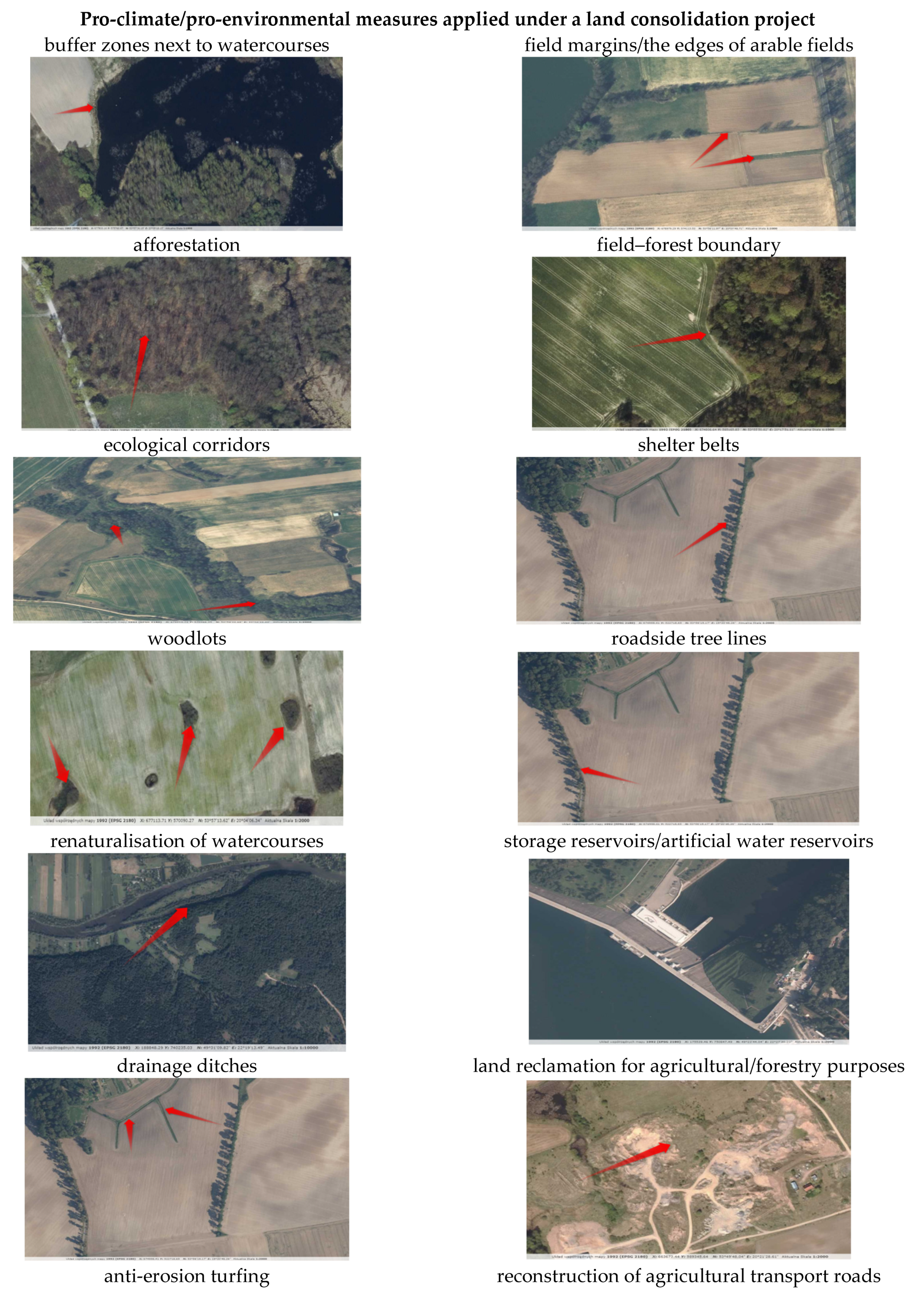

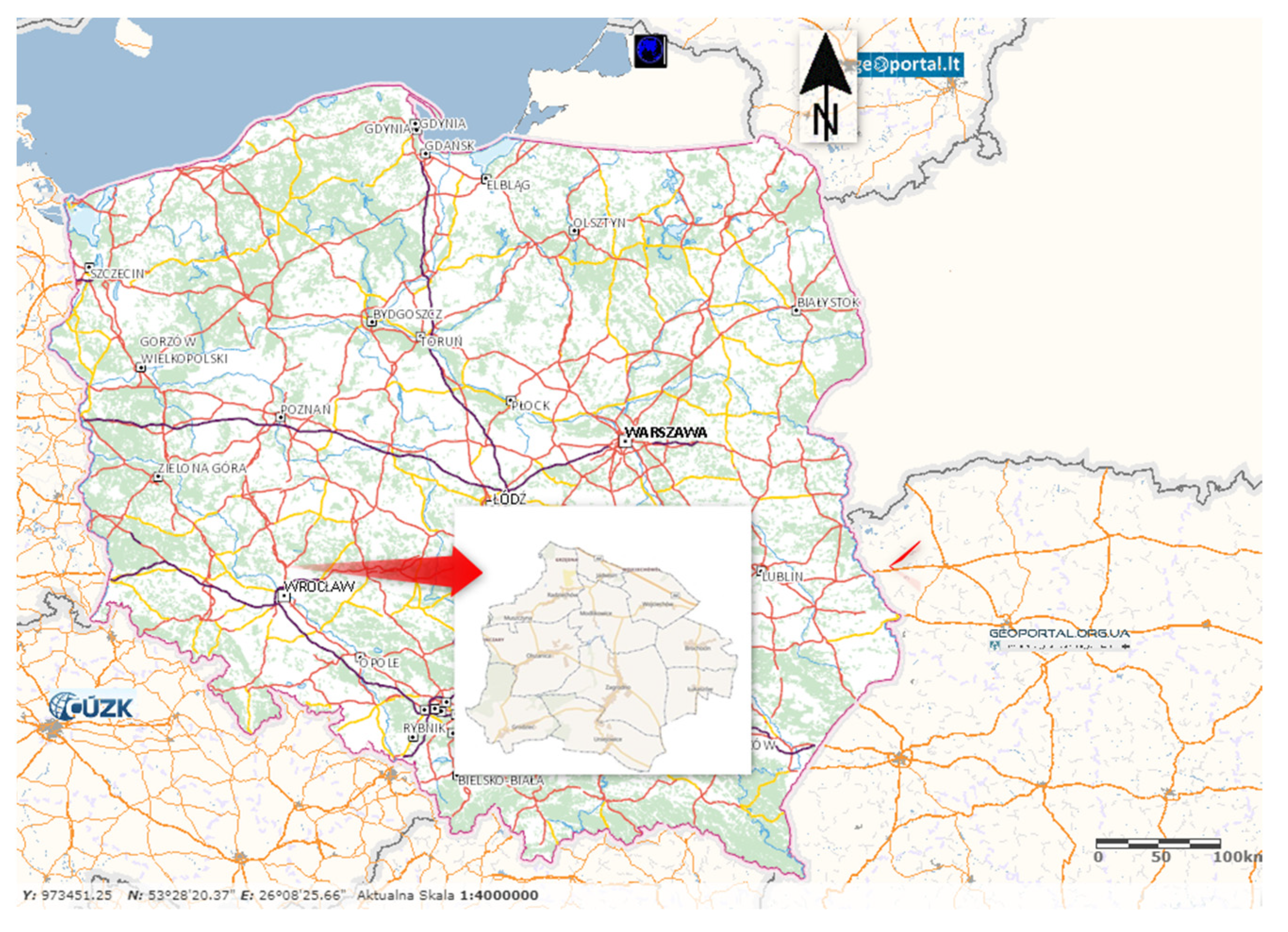
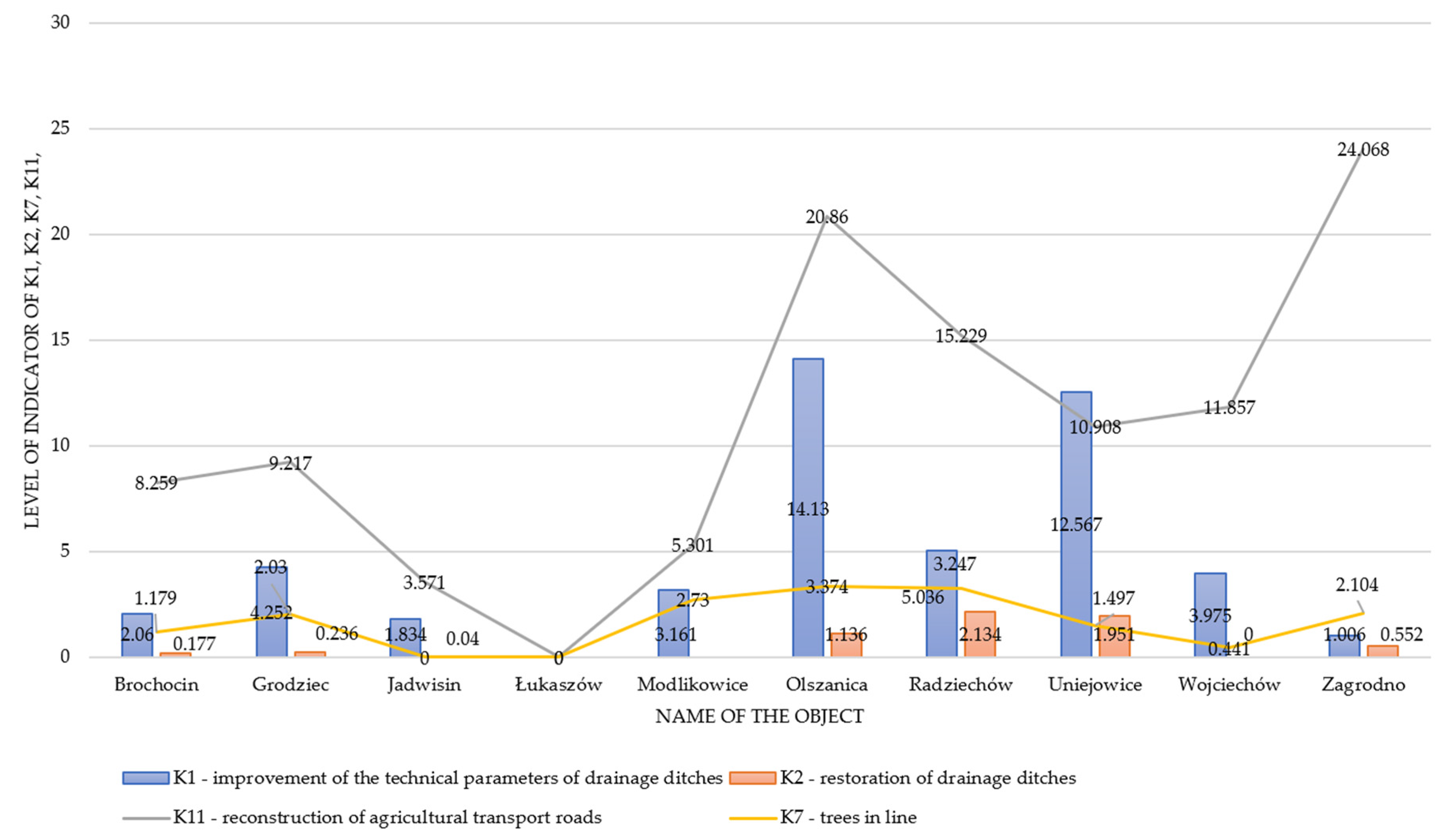
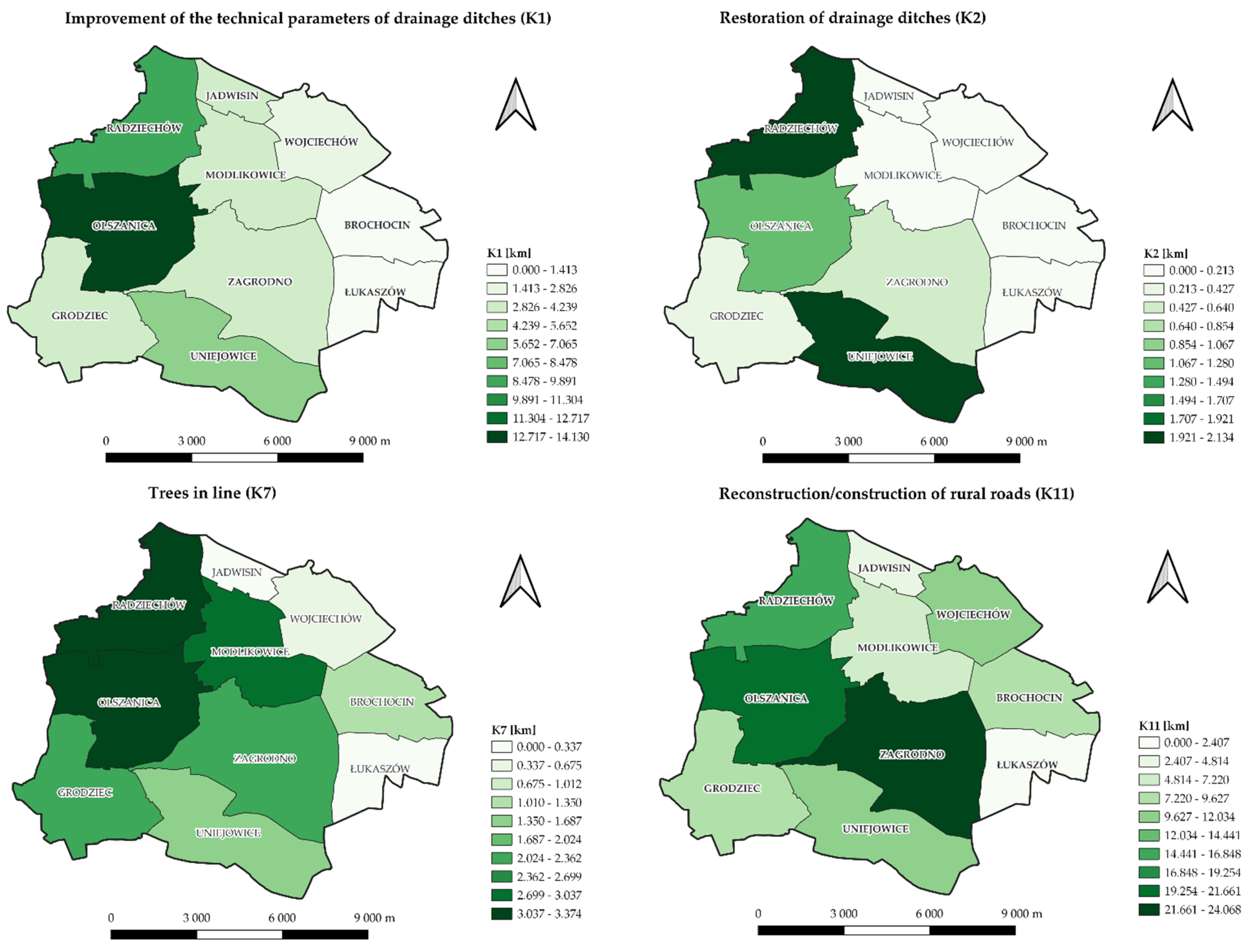
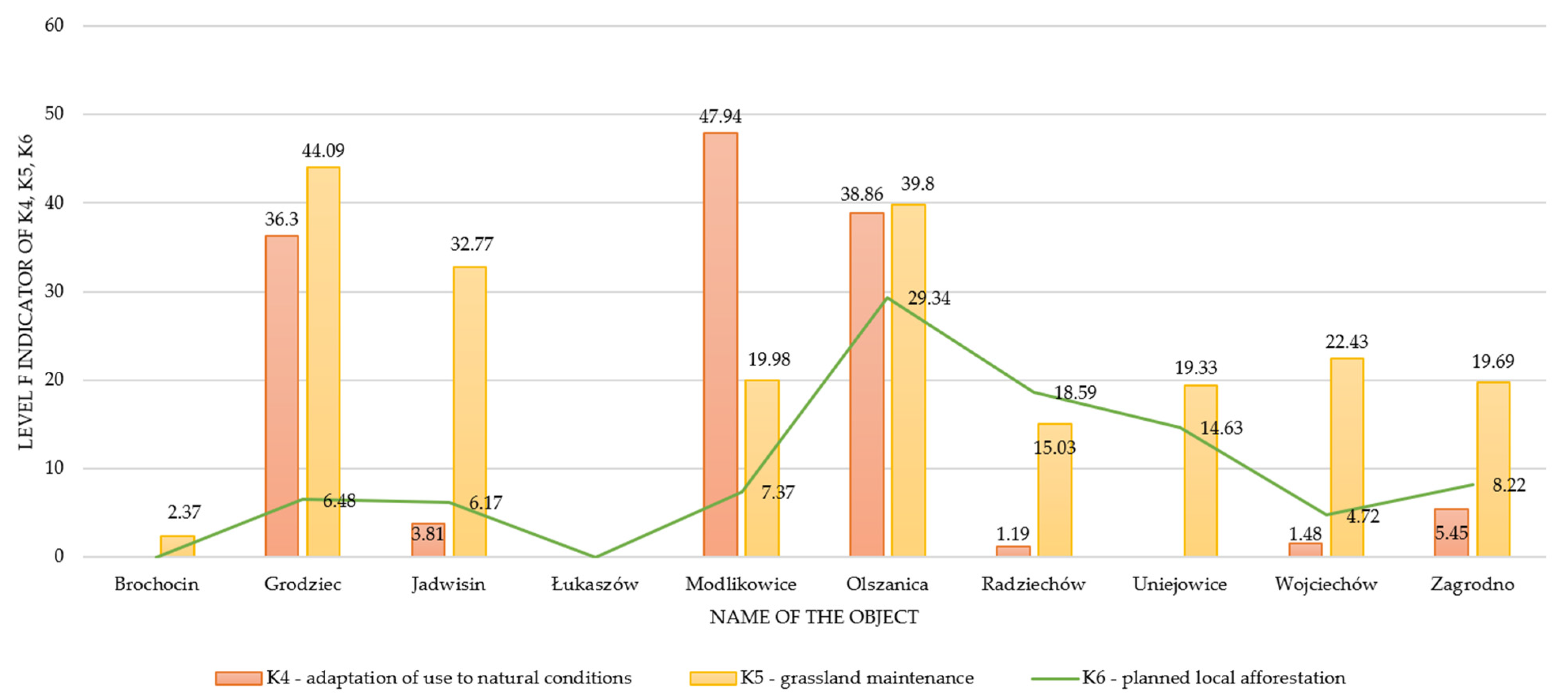
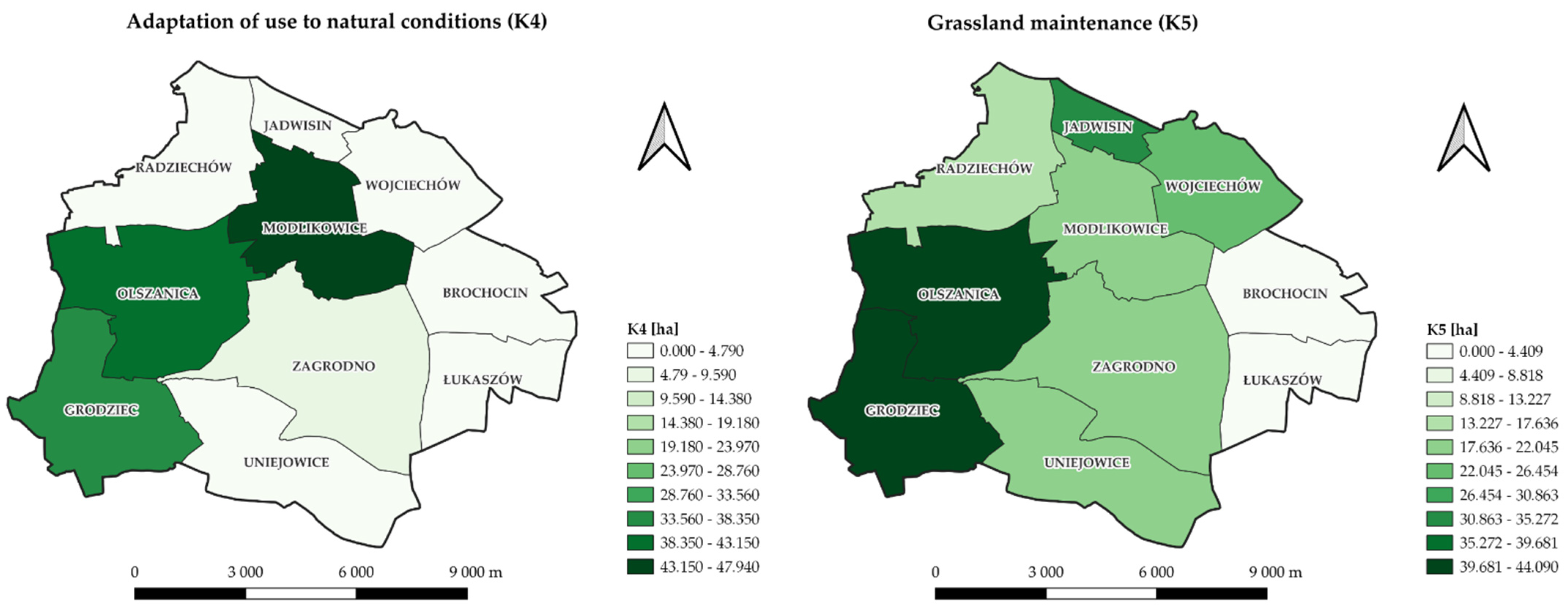
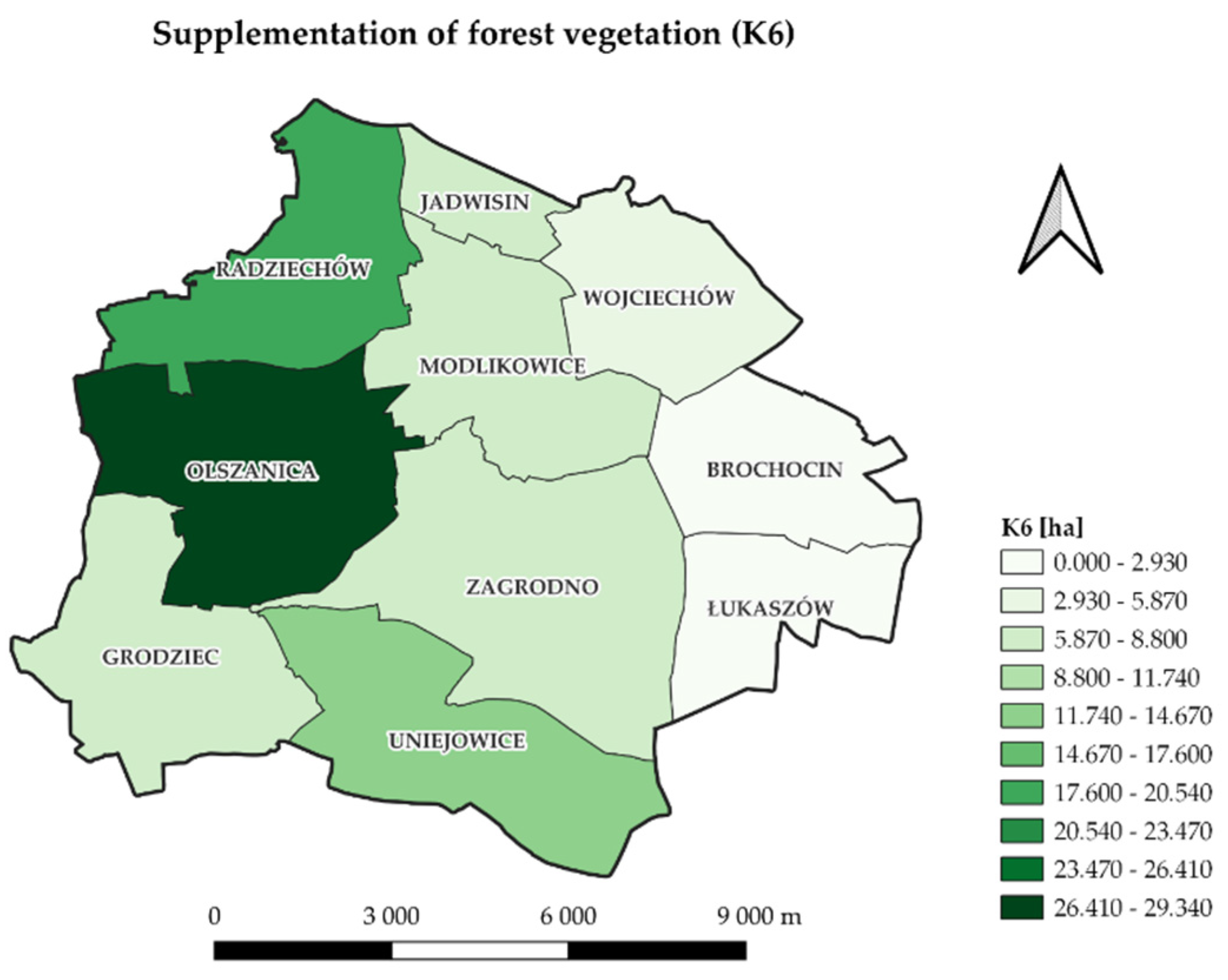


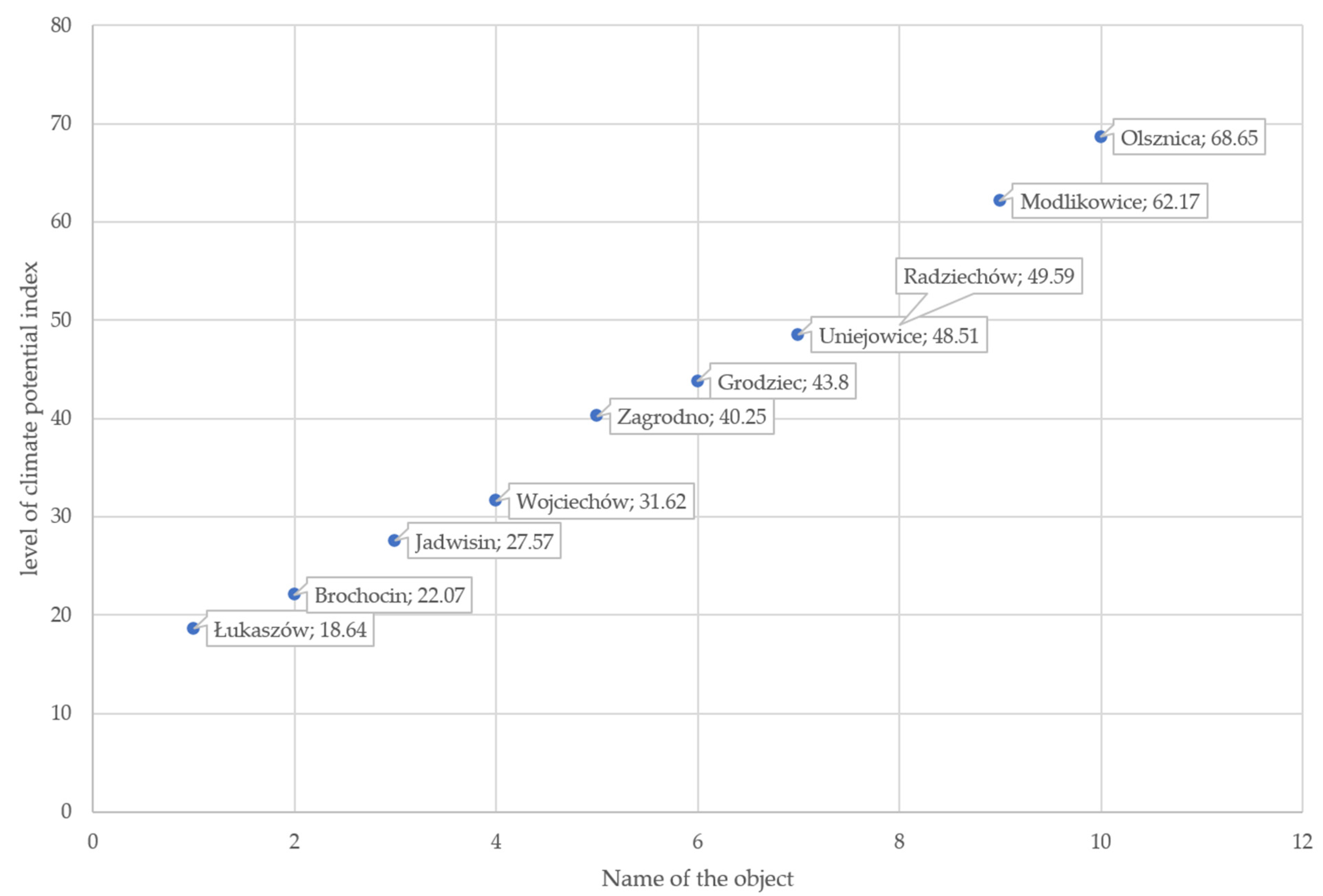

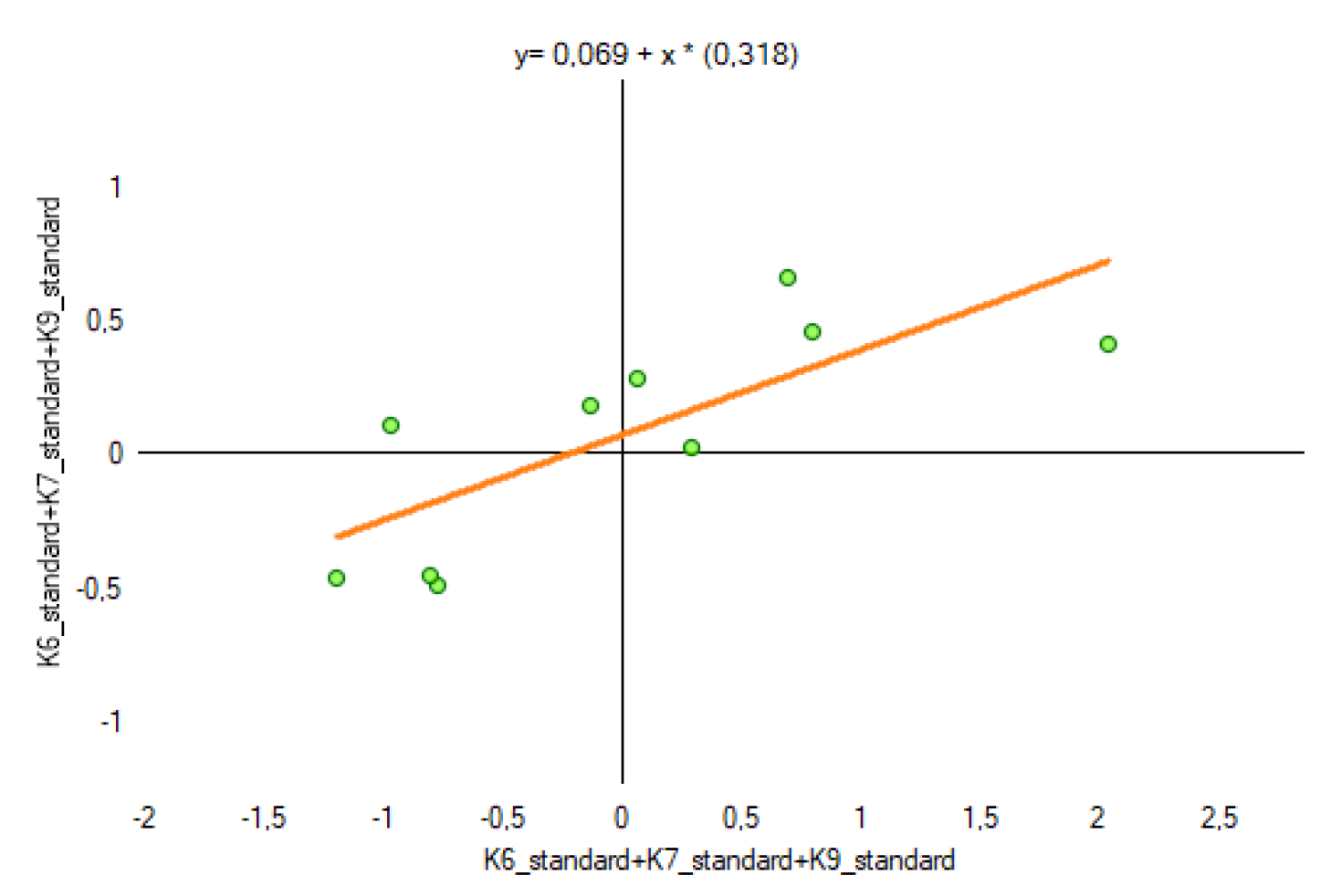
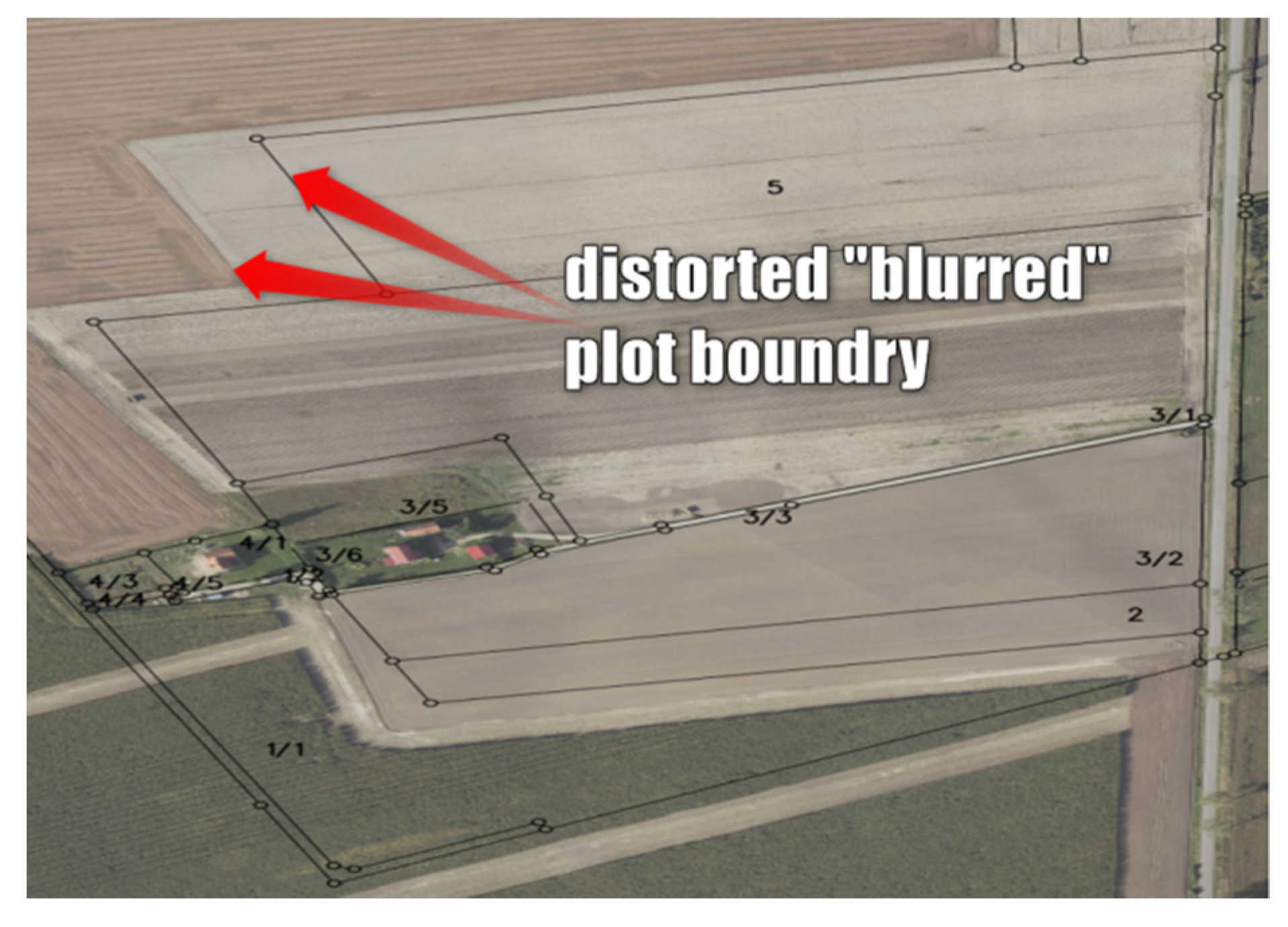
| Item | Name of Indicator | Symbol | Unit | Aver. | Min. | Max. | Coefficient of Variation |
|---|---|---|---|---|---|---|---|
| 1 | Improvement of the technical parameters of drainage ditches | K1 | km | 4.80 | 0.00 | 14.13 | 99.346 |
| 2 | Restoration of drainage ditches | K2 | km | 0.62 | 0.00 | 2.13 | 132.965 |
| 3 | Reconstruction of ponds | K3 | ha | 0.23 | 0.00 | 0.72 | 134.989 |
| 4 | Adaptation of use to natural conditions | K4 | ha | 13.50 | 0.00 | 47.94 | 142.891 |
| 5 | Grassland maintenance | K5 | ha | 21.55 | 0.00 | 44.09 | 66.594 |
| 6 | Supplementation of forest vegetation in areas where the natural succession process has started—planned local afforestation | K6 | ha | 9.55 | 0.00 | 29.34 | 94.433 |
| 7 | Trees in line | K7 | km | 1.66 | 0.00 | 3.37 | 75.634 |
| 8 | Development of set-aside land for agricultural purposes | K8 | ha | 0.70 | 0.00 | 3.52 | 159.207 |
| 9 | Development of set-aside land for forestry purposes | K9 | ha | 2.89 | 0.00 | 9.88 | 126.778 |
| 10 | Wasteland reclamation | K10 | ha | 1.61 | 0.00 | 4.35 | 92.928 |
| 11 | Reconstruction/construction of agricultural transport roads | K11 | km | 10.93 | 0.00 | 24.07 | 68.615 |
| Item | Name of the Object | Symbol of the Object | Features | ||||||||||
|---|---|---|---|---|---|---|---|---|---|---|---|---|---|
| K1 | K2 | K3 | K4 | K5 | K6 | K7 | K8 | K9 | K10 | K11 | |||
| 1 | Brochocin | A | 0.146 | 0.083 | 0.000 | 0.000 | 0.054 | 0.000 | 0.349 | 1.000 | 0.019 | 0.120 | 0.657 |
| 2 | Grodziec | B | 0.301 | 0.111 | 0.000 | 0.757 | 1.000 | 0.221 | 0.602 | 0.000 | 0.929 | 0.280 | 0.617 |
| 3 | Jadwisin | C | 0.130 | 0.019 | 0.000 | 0.079 | 0.743 | 0.210 | 0.000 | 1.000 | 0.000 | 0.000 | 0.852 |
| 4 | Łukaszów | D | 0.000 | 0.000 | 0.000 | 0.000 | 0.000 | 0.000 | 0.000 | 1.000 | 0.000 | 0.051 | 1.000 |
| 5 | Modlikowice | E | 0.224 | 0.000 | 1.000 | 1.000 | 0.453 | 0.251 | 0.809 | 1.000 | 0.322 | 1.000 | 0.780 |
| 6 | Olszanica | F | 1.000 | 0.532 | 0.000 | 0.811 | 0.903 | 1.000 | 1.000 | 0.821 | 1.000 | 0.352 | 0.133 |
| 7 | Radziechów | G | 0.356 | 1.000 | 0.528 | 0.025 | 0.341 | 0.634 | 0.634 | 0.537 | 0.250 | 0.455 | 0.367 |
| 8 | Uniejowice | H | 0.889 | 0.914 | 0.000 | 0.000 | 0.438 | 0.499 | 0.499 | 0.852 | 0.231 | 0.522 | 0.547 |
| 9 | Wojciechów | I | 0.281 | 0.000 | 0.694 | 0.031 | 0.509 | 0.161 | 0.161 | 1.000 | 0.099 | 0.064 | 0.507 |
| 10 | Zagrodno | J | 0.071 | 0.259 | 0.917 | 0.114 | 0.447 | 0.280 | 0.280 | 0.790 | 0.079 | 0.848 | 0.000 |
| Indexes | K1 | K1 + K2 + K3 | K6 + K7 + K9 |
|---|---|---|---|
| Moran’s I Index | −0.04553 | −0.07598 | 0.31791 |
| Expected Index | −0.11111 | −0.11111 | −0.11111 |
| Variance | 0.03451 | 0.03982 | 0.03329 |
| z-score | −0.35386 | 0.17601 | 2.35126 |
| p-value | 0.72344 | 0.86028 | 0.01871 |
Disclaimer/Publisher’s Note: The statements, opinions and data contained in all publications are solely those of the individual author(s) and contributor(s) and not of MDPI and/or the editor(s). MDPI and/or the editor(s) disclaim responsibility for any injury to people or property resulting from any ideas, methods, instructions or products referred to in the content. |
© 2023 by the authors. Licensee MDPI, Basel, Switzerland. This article is an open access article distributed under the terms and conditions of the Creative Commons Attribution (CC BY) license (https://creativecommons.org/licenses/by/4.0/).
Share and Cite
Kocur-Bera, K.; Rapiński, J.; Siejka, M.; Leń, P.; Małek, A. Potential of an Area in Terms of Pro-Climate Solutions in a Land Consolidation Project. Sustainability 2023, 15, 9306. https://doi.org/10.3390/su15129306
Kocur-Bera K, Rapiński J, Siejka M, Leń P, Małek A. Potential of an Area in Terms of Pro-Climate Solutions in a Land Consolidation Project. Sustainability. 2023; 15(12):9306. https://doi.org/10.3390/su15129306
Chicago/Turabian StyleKocur-Bera, Katarzyna, Jacek Rapiński, Monika Siejka, Przemysław Leń, and Anna Małek. 2023. "Potential of an Area in Terms of Pro-Climate Solutions in a Land Consolidation Project" Sustainability 15, no. 12: 9306. https://doi.org/10.3390/su15129306
APA StyleKocur-Bera, K., Rapiński, J., Siejka, M., Leń, P., & Małek, A. (2023). Potential of an Area in Terms of Pro-Climate Solutions in a Land Consolidation Project. Sustainability, 15(12), 9306. https://doi.org/10.3390/su15129306









